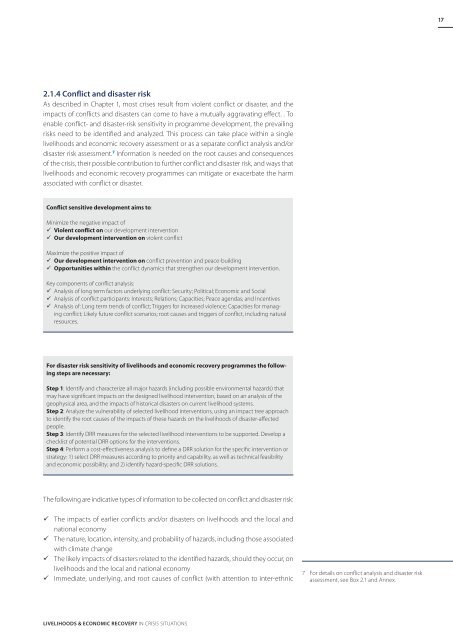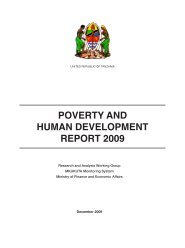Download PDF (4.08 MB) - ReliefWeb
Download PDF (4.08 MB) - ReliefWeb
Download PDF (4.08 MB) - ReliefWeb
Create successful ePaper yourself
Turn your PDF publications into a flip-book with our unique Google optimized e-Paper software.
17<br />
2.1.4 Conflict and disaster risk<br />
As described in Chapter 1, most crises result from violent conflict or disaster, and the<br />
impacts of conflicts and disasters can come to have a mutually aggravating effect. . To<br />
enable conflict- and disaster-risk sensitivity in programme development, the prevailing<br />
risks need to be identified and analyzed. This process can take place within a single<br />
livelihoods and economic recovery assessment or as a separate conflict analysis and/or<br />
disaster risk assessment. 7 Information is needed on the root causes and consequences<br />
of the crisis, their possible contribution to further conflict and disaster risk, and ways that<br />
livelihoods and economic recovery programmes can mitigate or exacerbate the harm<br />
associated with conflict or disaster.<br />
Conflict sensitive development aims to:<br />
Minimize the negative impact of<br />
Violent conflict on our development intervention<br />
Our development intervention on violent conflict<br />
Maximize the positive impact of<br />
Our development intervention on conflict prevention and peace-building<br />
Opportunities within the conflict dynamics that strengthen our development intervention.<br />
Key components of conflict analysis:<br />
Analysis of long term factors underlying conflict: Security; Political; Economic and Social<br />
Analysis of conflict participants: Interests; Relations; Capacities; Peace agendas; and Incentives<br />
Analysis of: Long term trends of conflict; Triggers for increased violence; Capacities for managing<br />
conflict; Likely future conflict scenarios; root causes and triggers of conflict, including natural<br />
resources.<br />
For disaster risk sensitivity of livelihoods and economic recovery programmes the following<br />
steps are necessary:<br />
Step 1: Identify and characterize all major hazards (including possible environmental hazards) that<br />
may have significant impacts on the designed livelihood intervention, based on an analysis of the<br />
geophysical area, and the impacts of historical disasters on current livelihood systems.<br />
Step 2: Analyze the vulnerability of selected livelihood interventions, using an impact tree approach<br />
to identify the root causes of the impacts of these hazards on the livelihoods of disaster-affected<br />
people.<br />
Step 3: Identify DRR measures for the selected livelihood interventions to be supported. Develop a<br />
checklist of potential DRR options for the interventions.<br />
Step 4: Perform a cost-effectiveness analysis to define a DRR solution for the specific intervention or<br />
strategy: 1) select DRR measures according to priority and capability, as well as technical feasibility<br />
and economic possibility; and 2) identify hazard-specific DRR solutions.<br />
The following are indicative types of information to be collected on conflict and disaster risk:<br />
The impacts of earlier conflicts and/or disasters on livelihoods and the local and<br />
national economy<br />
The nature, location, intensity, and probability of hazards, including those associated<br />
with climate change<br />
The likely impacts of disasters related to the identified hazards, should they occur, on<br />
livelihoods and the local and national economy<br />
Immediate, underlying, and root causes of conflict (with attention to inter-ethnic<br />
7 For details on conflict analysis and disaster risk<br />
assessment, see Box 2.1 and Annex.<br />
Livelihoods & Economic Recovery in Crisis Situations





